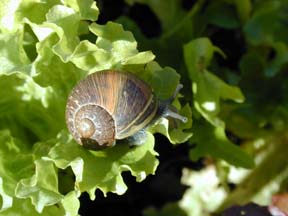|
Give peace a chanceby AMY STEWART I HAD A LETTER A WHILE BACK FROM A reader who had this to say about my Christmas Day garden column: "I found it very odd that
in a piece extolling the simple pleasures of life -- the joy
and silence of Christmas, sounds of birds and the wind, and the
tending of a garden -- that you would include this sentence:
`Tossing snails into the street is an entertaining and invigorating
way to send them to their doom.' "The need to eliminate these pests from your garden may be necessary, but to take such obvious delight in their destruction is unsettling. A snail is still a living thing. It's this kind of mentality that people continue to use to justify the killing of lesser creatures. Respect for life should be upheld by those intelligent enough to know better." You know, I actually agree with those sentiments completely, and that's one reason why I'm a vegetarian. I hope that you carnivores out there approached your Christmas turkey/goose/duck with remorse and sorrow, and studiously avoided saying anything that indicated that you might be taking pleasure in the death of this lesser creature, such as, "Honey, this is your best turkey ever," or "This sure will be good on sandwiches tomorrow." Statements like that only justify the further slaughter of innocent poultry and inevitably contribute to the culture of violence that leads us into unjustified wars around the world and appalling violence at home. Having thrown my support wholeheartedly behind these peace-loving sentiments, I've decided to turn over a new leaf. I'm changing my approach to pest control in the garden. Non-toxic solutions just don't go far enough. They must be non-violent, too. Here, then are my suggestions for a new approach to non-violent pest control: Snails and Slugs: These are fairly substantial creatures, and as such, you should address them individually, not as a group. When you see a snail devouring a just-opened daffodil, or a slug curling up for a long winter's nap in your lettuce bed, ask them politely to leave. Snails and slugs are hard of hearing and as such, you may have to shout. I know that it is difficult to sound polite when you are yelling, but as long as you word it nicely, they don't take offense. Because most snails have not traveled widely, you may need to suggest somewhere for them to go. So for instance, on a Saturday morning you might walk around to the hundred or so snails gathered around your calla lilies and shout at each of them, "MRS. JOHNSON ACROSS THE STREET HAS JUST PLANTED SOME LOVELY SUNFLOWER SEEDLINGS. WHY DON'T YOU GO HAVE A LOOK?" If that doesn't work, you may have to gather them up and relocate them humanely to Mrs. Johnson's sunflower seedlings. Just place them gently in a flower pot and, once the pot is filled but before they start squirming around too much, carry them across the street and wish them well in their new home. Aphids and Whitefly: Most gardeners fail to appreciate the merits of these fine creatures. Aphids come in an enchanting range of colors from green to brown to black, and they complement almost any color scheme. Whitefly, when massed together as they sometimes prefer to do, almost look like a blotch of pure sunlight on a leaf. And on drab, chilly days, who wouldn't welcome a little brightness in the garden? So rather than inflict the kind of cruelty on aphids and whitefly that has been practiced by thoughtless, insensitive gardeners for centuries -- releasing predator ladybugs, spraying with insecticidal soap or dormant oil, or violently blasting them with the hose -- consider giving them a garden of their own. That's right, aphids and whitefly deserve to enjoy a garden, too. This is what habitat gardening is all about, people. I'm sure you know what they like: roses, sweet peas, artichokes, nasturtiums, tomatoes just put together an assortment of their favorite plants and situate it in a prime spot. If you find aphids or whitefly in any other part of your garden, simply assume they've gotten lost and help them find their way back to their own special corner of the garden. Clip the leaf or bud they're clinging to and carry them -- carefully, these little guys frighten easily -- back to their home. Gophers: Come on, we all know gophers make wonderful pets. Most children find them adorable and will be enchanted with the notion that the entire backyard is a tunnel-filled playground for adorable little Thumper or Spot. Yes, encourage the children to name the gophers and grow very attached to them. They can write stories about the gophers, draw enchanting little maps of their underground world, and just lie in the vegetable patch on a warm summer day and watch the gophers pull the string beans underground for lunch. Ah, the simple pleasures of a child's summer. If the kids get worried that their pets aren't getting enough to eat, remind them that the entire garden is a buffet for their little furry friends. Why, you can buy dozens and dozens of tulip bulbs in the fall and let the kids "hide" them in the ground for the gophers to find. It's more fun than an Easter egg hunt and good practice for the day when the kids grow up and have their own gophers to feed. Just imagine -- a happy, harmonious garden where the snails wander freely through the neighborhood, the aphids and whitefly can enjoy all the rose bushes they want, and gophers finally find the love and validation they've been seeking all along. Now, isn't that what gardening's all about?
garden-related announcements and news to Amy Stewart. IN THE NEWS | COVER STORY | EDITORIAL | CALENDAR © Copyright 2004, North Coast Journal, Inc. |


